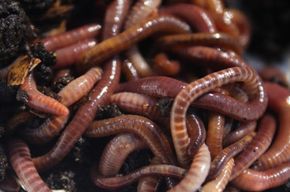Comprehending the Conveniences of Red Wiggler Composting: Just How This Reliable Approach Changes Organic Waste Into Nutrient-Rich Soil Amendments
Red Wiggler composting, using the types Eisenia fetida, offers a compelling approach to organic waste monitoring, converting kitchen scraps and backyard particles into useful soil changes. This approach not only improves dirt fertility yet also addresses pressing environmental concerns, including land fill waste reduction and greenhouse gas emissions. As we explore the details of this procedure, the complex advantages it offers may expose unforeseen understandings right into lasting techniques and ecological balance. Recognizing these measurements may motivate a reevaluation of exactly how we regard waste and its possible contributions to a healthier planet.
What Are Red Wigglers?
Red wigglers, clinically referred to as Eisenia fetida, are a species of earthworm that play an essential role in vermicomposting systems. These worms are defined by their reddish-brown shade, segmented bodies, and an unique ability to prosper in organic-rich environments, making them perfect for composting applications - Red Wiggler Composting. Unlike their garden-dwelling counterparts, red wigglers prefer to populate the top layers of dirt, where decomposing matter is bountiful
Usually determining between 3 to 4 inches in size, red wigglers have a high reproductive rate, allowing them to increase swiftly under optimal conditions. They have a special digestive system that permits them to process natural waste effectively, transforming it into nutrient-rich castings, which are highly valuable for plant development.
Their resistance to varying dampness degrees and temperature ranges further improves their utility in vermicomposting configurations, making them a popular choice amongst composting enthusiasts. Additionally, red wigglers are cardiovascular microorganisms, which demands a well-aerated composting environment, ensuring effective disintegration. Recognizing the organic qualities and actions of red wigglers is vital for enhancing their use in sustainable waste administration techniques.

Benefits of Vermicomposting
Harnessing the power of vermicomposting deals a multitude of farming and ecological benefits. It substantially minimizes natural waste in garbage dumps, thus reducing methane exhausts, a powerful greenhouse gas. By diverting food scraps and yard waste to vermicomposting, we sustain an even more lasting waste management system.
Furthermore, vermicomposting boosts dirt wellness. The spreadings produced by red wigglers are abundant in important nutrients, germs, and enzymes, improving dirt structure and fertility. This nutrient-rich modification advertises durable plant development and enhances water retention, decreasing the need for chemical fertilizers.
Furthermore, vermicomposting fosters biodiversity in the soil environment. The introduction of valuable microorganisms from worm spreadings help in condition suppression and nutrient cycling, developing a healthier environment for plants.
Economically, vermicomposting minimizes the expenses connected with chemical inputs and garbage disposal. Farmers and garden enthusiasts can grow top quality fruit and vegetables at lower expenses, adding to food safety and security and sustainability.
Just How to Begin Composting
Starting a composting endeavor can be a gratifying and straightforward process. This will certainly help maintain a balanced temperature, essential for the composting procedure.
Gather organic products such as cooking area scraps, lawn waste, and shredded paper. Go for a well balanced mix of 'eco-friendly' materials, high in nitrogen (e.g., fruit scraps, coffee grounds), and 'brownish' products, abundant in carbon (e.g., dried leaves, cardboard) A ratio of approximately 2:1 green to brown materials is optimal.
Start layering your materials, making sure adequate air circulation by transforming the heap on a regular basis. This advertises cardiovascular decomposition, reducing odors and speeding up the process. Screen wetness degrees; the compost must seem like a damp sponge however not excessively wet.
Nutrient Account of Vermicompost
Composting, particularly with red wigglers, generates a nutrient-rich item recognized as vermicompost. This organic change is identified by its high concentration of essential nutrients, making it an special info indispensable source for gardening and agriculture. Vermicompost typically has elevated degrees of macronutrients such as nitrogen, phosphorus, and potassium, which are vital for plant development. In addition, it offers micronutrients like calcium, magnesium, and iron, promoting robust plant advancement and boosting soil health.
The microbial task existing in vermicompost better enriches its profile, introducing beneficial bacteria and fungi that advertise nutrition schedule and uptake in plants. This organic component aids in subduing plant diseases and boosting dirt structure, resulting in improved water retention and oygenation.

Environmental Effect of Composting
The environmental influence of composting, especially via using red wigglers, is extensive and complex. This method significantly lowers the volume of natural waste sent out to landfills, which consequently lessens greenhouse gas discharges, specifically methane-- a powerful factor to climate change. By drawing away organic products from landfills, red wiggler composting not only helps reduce ecological degradation however additionally promotes More Info sustainable waste Look At This administration techniques.

In addition, composting adds to carbon sequestration, as the procedure captures carbon dioxide from the atmosphere and stores it in the soil. This natural process aids in combating climate change while enriching the soil - Red Wiggler Composting. In general, red wiggler composting provides a sensible, eco-friendly solution for waste administration and ecological sustainability, advertising healthier environments and a much more sustainable future
Final Thought
In final thought, Red Wiggler composting serves as a reliable technique for converting natural waste into beneficial soil modifications. The process not just improves dirt fertility and structure yet likewise minimizes environmental concerns connected with waste disposal.
Red Wiggler composting, using the species Eisenia fetida, offers a compelling technique to organic waste administration, transforming kitchen area scraps and backyard debris into beneficial soil modifications. Unlike their garden-dwelling counterparts, red wigglers like to inhabit the upper layers of dirt, where rotting matter is plentiful.
The spreadings produced by red wigglers are abundant in essential nutrients, microorganisms, and enzymes, boosting soil structure and fertility. The nutrient-rich by-products of red wiggler task improve soil structure, rise water retention, and promote biodiversity within the soil ecosystem.In final thought, Red Wiggler composting offers as an effective technique for transforming organic waste right into valuable dirt amendments.